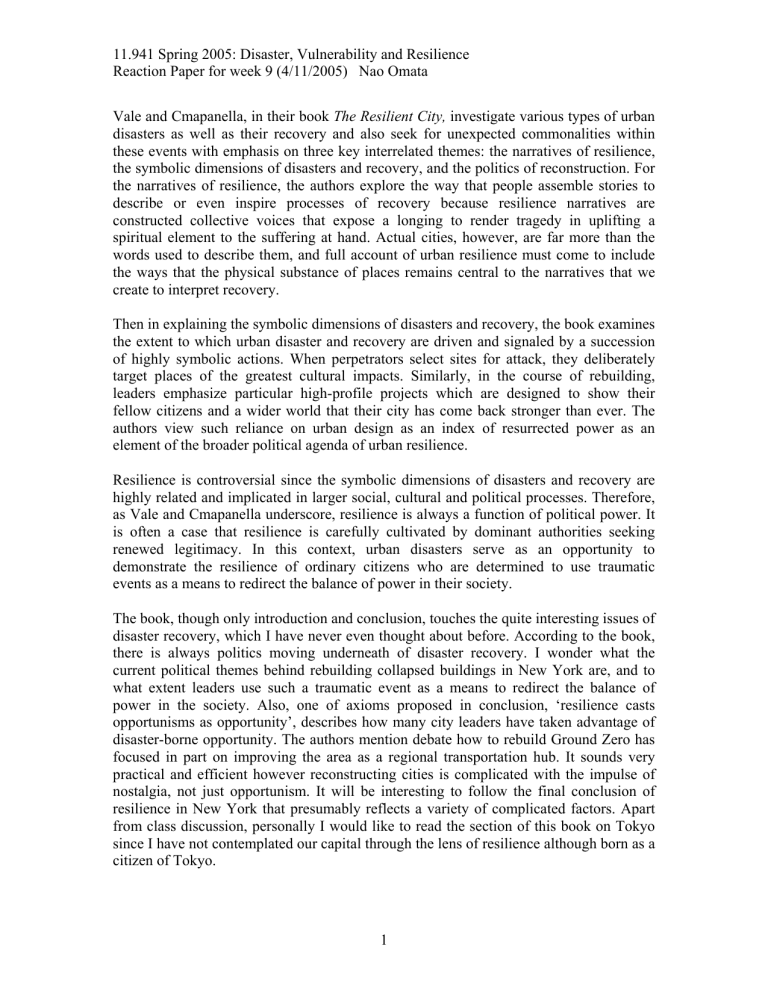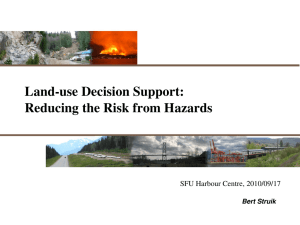11.941 Spring 2005: Disaster, Vulnerability and Resilience

11.941 Spring 2005: Disaster, Vulnerability and Resilience
Reaction Paper for week 9 (4/11/2005) Nao Omata
Vale and Cmapanella, in their book The Resilient City, investigate various types of urban disasters as well as their recovery and also seek for unexpected commonalities within these events with emphasis on three key interrelated themes: the narratives of resilience, the symbolic dimensions of disasters and recovery, and the politics of reconstruction. For the narratives of resilience, the authors explore the way that people assemble stories to describe or even inspire processes of recovery because resilience narratives are constructed collective voices that expose a longing to render tragedy in uplifting a spiritual element to the suffering at hand. Actual cities, however, are far more than the words used to describe them, and full account of urban resilience must come to include the ways that the physical substance of places remains central to the narratives that we create to interpret recovery.
Then in explaining the symbolic dimensions of disasters and recovery, the book examines the extent to which urban disaster and recovery are driven and signaled by a succession of highly symbolic actions. When perpetrators select sites for attack, they deliberately target places of the greatest cultural impacts. Similarly, in the course of rebuilding, leaders emphasize particular high-profile projects which are designed to show their fellow citizens and a wider world that their city has come back stronger than ever. The authors view such reliance on urban design as an index of resurrected power as an element of the broader political agenda of urban resilience.
Resilience is controversial since the symbolic dimensions of disasters and recovery are highly related and implicated in larger social, cultural and political processes. Therefore, as Vale and Cmapanella underscore, resilience is always a function of political power. It is often a case that resilience is carefully cultivated by dominant authorities seeking renewed legitimacy. In this context, urban disasters serve as an opportunity to demonstrate the resilience of ordinary citizens who are determined to use traumatic events as a means to redirect the balance of power in their society.
The book, though only introduction and conclusion, touches the quite interesting issues of disaster recovery, which I have never even thought about before. According to the book, there is always politics moving underneath of disaster recovery. I wonder what the current political themes behind rebuilding collapsed buildings in New York are, and to what extent leaders use such a traumatic event as a means to redirect the balance of power in the society. Also, one of axioms proposed in conclusion, ‘resilience casts opportunisms as opportunity’, describes how many city leaders have taken advantage of disaster-borne opportunity. The authors mention debate how to rebuild Ground Zero has focused in part on improving the area as a regional transportation hub. It sounds very practical and efficient however reconstructing cities is complicated with the impulse of nostalgia, not just opportunism. It will be interesting to follow the final conclusion of resilience in New York that presumably reflects a variety of complicated factors. Apart from class discussion, personally I would like to read the section of this book on Tokyo since I have not contemplated our capital through the lens of resilience although born as a citizen of Tokyo.
1






